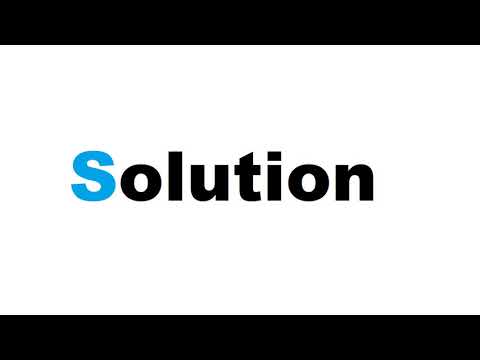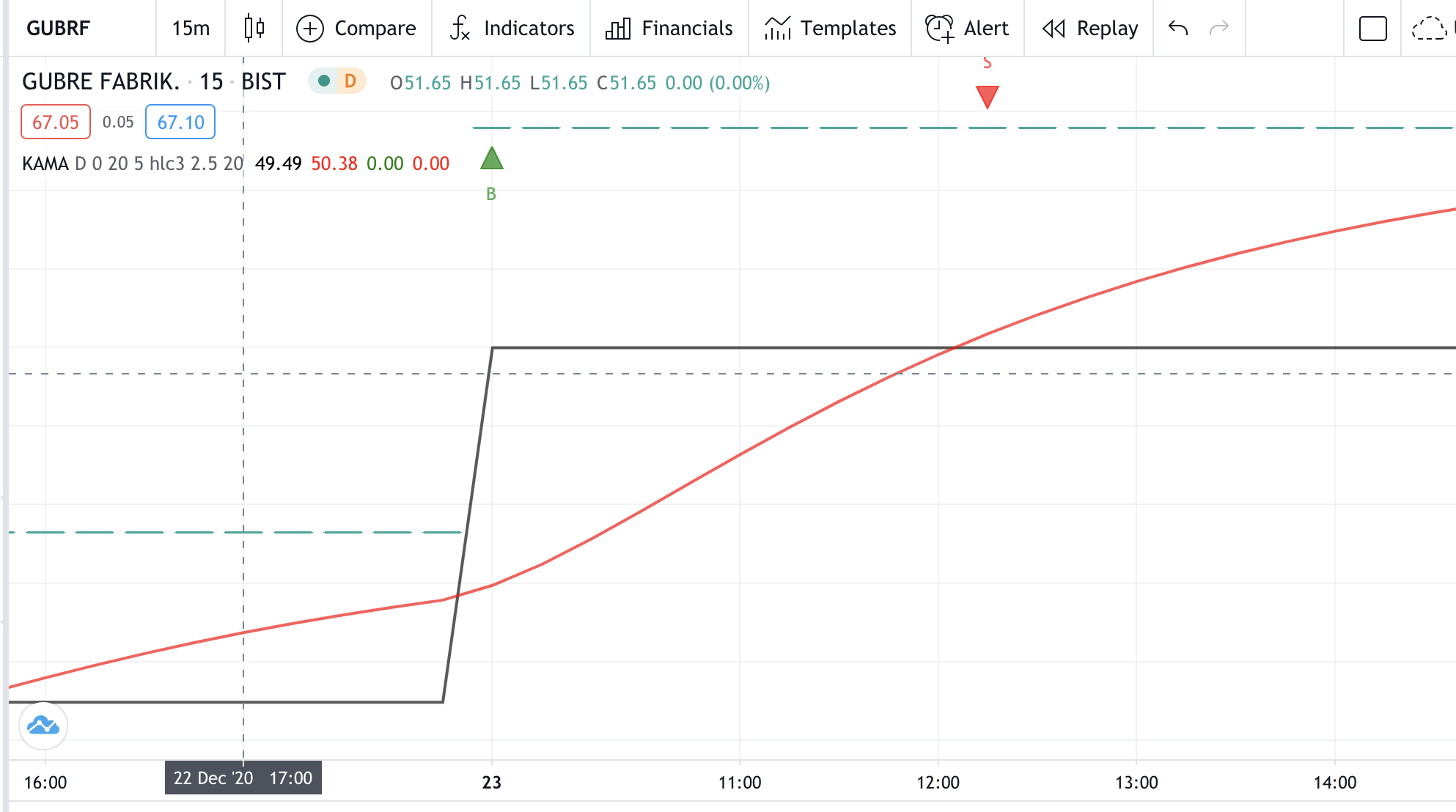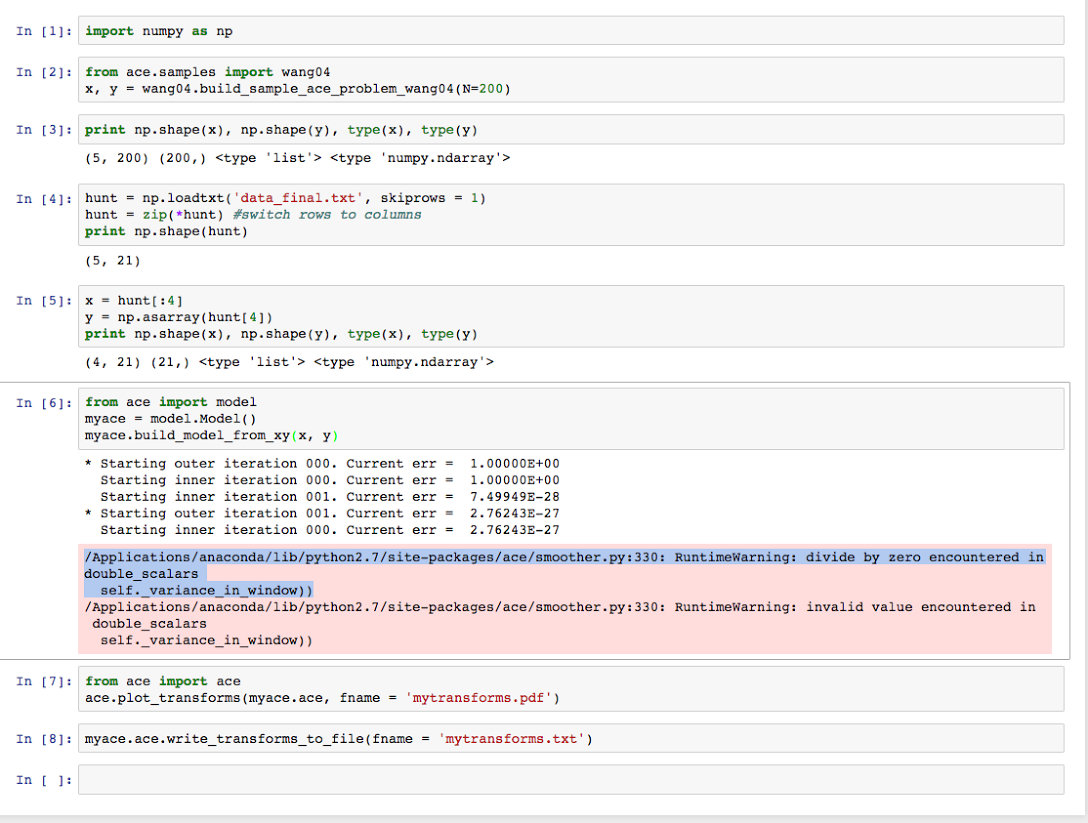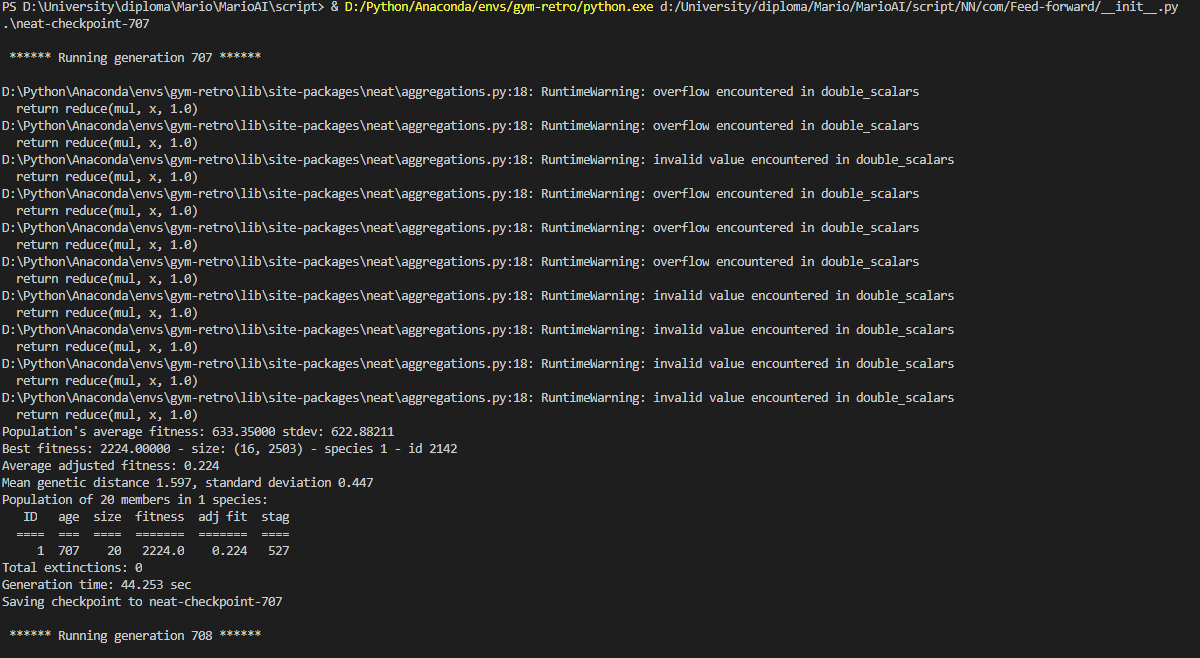Runtimewarning Invalid Value Encountered In Double_Scalars
When working with numerical computations in programming languages such as Python, you may encounter a RuntimeWarning with the message “invalid value encountered in double_scalars.” This warning typically indicates that there has been an overflow or underflow issue while performing mathematical calculations involving double-precision floating-point numbers, also known as double scalars.
Double scalars are a commonly used data type for representing real numbers, particularly in scientific and numerical computing. They provide a compromise between precision and storage space, enabling efficient calculations with a reasonable level of accuracy. However, due to the finite range of values they can represent, certain operations may lead to errors or unexpected results.
Possible Causes of the RuntimeWarning
1. Overflow or Underflow: The most common cause of the RuntimeWarning is an overflow or underflow during a mathematical operation involving double scalars. This occurs when the result of the operation exceeds the maximum or minimum representable value of the data type. For example, dividing a very large number by a small one may result in overflow, while subtracting two almost equal numbers can lead to underflow.
2. Inappropriate Mathematical Operations: Certain mathematical operations may not be compatible with the data type or the values involved. Taking the square root of a negative number, for instance, is not defined for real numbers and can trigger the RuntimeWarning.
3. Dividing by Zero or Infinity: Division by zero is undefined in mathematics and programming, as it violates fundamental principles. If your code includes a division operation where the denominator is zero or tends to infinity, the RuntimeWarning may occur.
4. Inconsistent Data Types: Mixing incompatible data types in mathematical operations can lead to unexpected behaviors. If your code combines double scalars with other data types, such as integers or complex numbers, and the operation is not well-defined, the invalid value RuntimeWarning may arise.
5. Precision Loss in Floating-Point Calculations: Floating-point arithmetic introduces some inherent imprecision due to the finite representation of real numbers in computers. Accumulation of rounding errors or loss of precision in intermediate calculations can result in invalid values being encountered during subsequent operations.
6. Incompatible Libraries or Versions: Another possible cause is using incompatible libraries or different versions of the same library that handle floating-point calculations differently. Inconsistent treatment of special values like NaN (Not a Number) or Inf (Infinity) can trigger the RuntimeWarning.
Potential Consequences and Troubleshooting Tips
The RuntimeWarning “invalid value encountered in double_scalars” serves as an informative message rather than an immediate error. It does not stop the program from running, but it alerts you to potential issues in your code. The consequences of encountering this warning can vary depending on the specific context and the subsequent actions your code takes.
1. Incorrect Results: The most obvious consequence is that your code may produce incorrect or unexpected results. The invalid value encountered in double_scalars typically indicates a problem with a specific calculation or a series of computations. Therefore, it is crucial to identify and resolve the cause to ensure accurate outcomes.
2. Unpredictable Behavior: In some cases, encountering the RuntimeWarning may lead to unpredictable behavior in your code. It can cause your program to crash, produce NaN (Not a Number) or Inf (Infinity) values, or generate other runtime errors. Addressing the root cause of the warning can help avoid such issues.
To troubleshoot and resolve the invalid value RuntimeWarning, consider the following tips:
1. Check for Input Validity: Before performing mathematical operations, validate your input data. Ensure that it is within the appropriate range and well-defined for the chosen operation. For instance, if you intend to compute a square root, ensure that the input is non-negative.
2. Handle Division by Zero: If your code involves divisions, add appropriate checks to handle division by zero. You can use conditional statements to avoid such scenarios or handle exceptions when dividing by zero occurs.
3. Verify Data Types: Double-check that all the variables involved in computations have compatible data types. Mixing data types incorrectly can result in unexpected behavior. Convert variables when necessary to ensure consistency.
4. Consider Alternative Approaches: If certain operations consistently trigger the RuntimeWarning, consider alternative approaches or algorithms that better suit your specific calculations. Choose libraries or functions that offer enhanced precision and stability.
5. Update Libraries: Ensure that you are using compatible versions of libraries involved in your code. Keeping your libraries up to date can help avoid compatibility issues and inconsistencies in floating-point calculations.
6. Enable Error Handling: Configure your programming environment or code to catch warnings as errors. This approach can help you identify and fix potential issues before they can cause further problems.
7. Debug and Test: If you are still encountering the RuntimeWarning, use debugging techniques to track down the specific operation or value causing the issue. Thoroughly test your code with various input data to ensure its robustness.
Conclusion
The RuntimeWarning “invalid value encountered in double_scalars” is a signal of potential issues in your code related to overflow, underflow, inappropriate mathematical operations, inconsistent data types, precision loss, or incompatible libraries. By understanding the possible causes and following the troubleshooting tips provided, you can address these issues and ensure accurate and reliable numerical computations.
FAQs
Q: What does the RuntimeWarning “invalid value encountered in subtract” mean?
A: This warning typically arises when subtracting two values, and the result encounters an invalid value, such as NaN (Not a Number) or Inf (Infinity). It may occur due to overflow, underflow, inconsistent data types, or inappropriate mathematical operations.
Q: Why do I receive the RuntimeWarning “mean of empty slice”?
A: This warning indicates that you are attempting to calculate the mean value of an empty slice, such as an empty array or a subset of data. Ensure that your input data has valid values and adjust your code to handle empty slices gracefully.
Q: What should I do if I encounter the RuntimeWarning “divide by zero encountered in double_scalars”?
A: The warning indicates that you are attempting to divide by zero, which is mathematically undefined. Check your code for divisions and apply appropriate checks to avoid dividing by zero or handle exceptions when it occurs.
Q: How can I resolve the RuntimeWarning “overflow encountered in exp”?
A: This warning suggests that the exponential function encountered an overflow, indicating that the result is too large to be represented by the double scalar data type. Consider using alternative approaches, such as logarithms or specialized libraries, to handle large exponents.
Q: What are some strategies to mitigate the precision loss in floating-point calculations?
A: To minimize precision loss, consider using higher precision data types, such as Decimal instead of double scalars. Additionally, rearrange the computation order or apply techniques like compensated summation to reduce the impact of rounding errors.
Python : Numpy Division With Runtimewarning: Invalid Value Encountered In Double_Scalars
How To Disable Runtimewarning Invalid Value Encountered In Double_Scalars?
The RuntimeWarning: Invalid value encountered in double_scalars is a common error faced by developers working with numerical computations in Python. This warning typically occurs when performing calculations involving a division by zero or other undefined mathematical operations. Although this warning is informative in most cases, sometimes it may clutter the output and hinder the readability of the code. In this article, we will discuss various methods to disable this warning, allowing developers to streamline their code execution.
Understanding the RuntimeWarning: Invalid Value Encountered in Double_Scalars
Before diving into the solutions, it is crucial to understand the nature of the warning and when it occurs. In Python, a double scalar refers to a floating-point number, often used in numerical computations. When performing mathematical operations involving these double scalars, there are some scenarios where the result becomes undefined. For instance, dividing a number by zero or calculating the square root of a negative number are undefined mathematical operations.
Python, by default, issues a warning when encountering these situations, informing developers about the potential issue. However, in some cases, especially when dealing with large computations or complex mathematical models, these warnings become abundant and obscure important output information. Let’s explore the ways to silence these warnings selectively or altogether.
Method 1: Using the Warnings Filter
Python’s warnings module provides a flexible solution to handle and filter warnings raised during the code execution. By modifying the warnings filter, we can configure Python to suppress RuntimeWarnings. Here’s an example:
“`python
import warnings
warnings.filterwarnings(“ignore”, category=RuntimeWarning)
“`
By utilizing the `filterwarnings()` function and specifying the `category` as `RuntimeWarning`, we instruct Python to ignore this specific warning during the code execution. This approach is useful when limiting the warning suppression to a specific section of code. Remember to include this code before the calculations generating the warning.
Method 2: Disabling Warnings Temporarily
In cases when the RuntimeWarning is expected and we only want to silence it for a specific calculation, the `numpy` library provides a context manager that temporarily suppresses warnings:
“`python
import numpy as np
with np.errstate(divide=’ignore’, invalid=’ignore’):
# Code generating the warning
“`
The `errstate()` context manager allows us to selectively suppress specific warnings related to arithmetic operations. In the above example, using `divide=’ignore’` and `invalid=’ignore’` assures that the RuntimeWarning regarding division by zero or undefined operations is not raised inside the context manager. This approach is useful when we want to suppress warnings selectively without changing the global warning settings.
Method 3: Modifying the Warnings Display Mode
Python also provides various options to adjust how warnings are displayed, including silencing specific warnings altogether. By changing the display mode, we can suppress the RuntimeWarning completely, thus ensuring it does not clutter the output. Here’s how the display mode can be modified:
“`python
import warnings
warnings.simplefilter(“ignore”)
“`
By utilizing the `simplefilter()` function with the argument set to `”ignore”`, we suppress all warnings, including RuntimeWarnings. However, it’s important to note that this approach may not be suitable if other warnings are being utilized for debugging or error detection. Therefore, it is advised to use this method thoughtfully and selectively.
Frequently Asked Questions (FAQs):
1. Should I always disable RuntimeWarnings?
Disabling RuntimeWarnings should be done judiciously. While silencing warnings can enhance code readability, it is important to remember that warnings exist for a reason. They often indicate potential issues or errors in the code. It is recommended to evaluate whether a warning is expected or erroneous before choosing to disable it.
2. Can I disable warnings globally in Python?
Python provides global settings to suppress warnings by modifying the `PYTHONWARNINGS` environment variable. However, it is not recommended to disable warnings globally, as it may hide important information and make debugging challenging. It is generally recommended to suppress warnings selectively, as discussed in the methods above.
3. Is it safe to divide by zero without handling the warning?
Dividing by zero is an undefined operation and should be handled carefully. While the warning can be disabled to silence the alert, it is essential to ensure proper handling of division by zero in the code. Ignoring the warning without addressing the underlying issue may lead to incorrect results or unwanted behavior in the program.
4. Can I selectively disable other warnings as well?
Yes, it is possible to selectively disable other warnings using similar approaches. By modifying the warning category or adjusting the warning filter, various types of warnings can be silenced. Care should be taken to ensure only the necessary warnings are disabled, as warnings often provide valuable insights into potential issues in the code.
In conclusion, the RuntimeWarning: Invalid value encountered in double_scalars is a commonly faced issue during numerical computation in Python. By utilizing the methods outlined in this article, developers can selectively disable or silence these warnings, improving code execution readability. However, it is advised to use these methods cautiously and understand the implications, as warnings provide valuable information that helps detect potential issues in the code.
What Are Double_Scalars In Python?
In the realm of computer programming, Python has emerged as one of the most popular and versatile programming languages. Known for its simplicity and readability, Python offers a wide range of data types and structures to handle various tasks efficiently. One such data type is the double_scalar, which is often used for mathematical computations involving decimal numbers. In this article, we will explore what double_scalars are in Python, their significance, and how they differ from other data types.
Understanding Double Scalars
In Python, a double_scalar is a data type that represents floating-point numbers with a high precision. Floating-point numbers, also known as floats, are used to store decimal numbers in programming languages. The term “double” in double_scalar refers to the fact that it uses a double-precision floating-point format to store and manipulate numerical values.
Double_scalars are commonly used when precise calculations are required, especially in scientific and numerical applications. This data type can accurately store and perform arithmetic operations on numbers with decimal places, ensuring minimal loss in precision.
Difference between Floats and Double Scalars
Python offers another data type called “float” that also stores decimal numbers. However, there are key distinctions between floats and double_scalars, primarily related to their precision.
Floats, as the name suggests, use single-precision floating-point format and typically occupy 32 bits of memory. They are designed to store decimal numbers with a reasonable level of precision. On the other hand, double_scalars use double-precision format and usually require 64 bits of memory. This extra precision allows for more accurate calculations involving decimal values.
While floats are sufficient for most general-purpose calculations, they may encounter rounding errors when dealing with certain mathematical operations. Double_scalars, with their higher precision, help minimize such errors and ensure more accurate results.
Working with Double Scalars in Python
Python provides an easy-to-use module called “decimal” to handle double_scalars efficiently. The decimal module allows Python programmers to perform precise decimal computations using the Decimal class.
To start working with double_scalars, we need to import the decimal module like this:
“`python
import decimal
“`
Once imported, we can create double_scalar objects using the Decimal class and perform various arithmetic operations on them. Here’s an example demonstrating some basic operations:
“`python
import decimal
# Creating double_scalar objects
num1 = decimal.Decimal(“3.14159”)
num2 = decimal.Decimal(“2.71828”)
# Arithmetic operations
addition = num1 + num2
subtraction = num1 – num2
multiplication = num1 * num2
division = num1 / num2
# Displaying the results
print(“Addition:”, addition)
print(“Subtraction:”, subtraction)
print(“Multiplication:”, multiplication)
print(“Division:”, division)
“`
In the above example, we create two double_scalar objects named “num1” and “num2” with the help of the Decimal class. We then perform basic arithmetic operations such as addition, subtraction, multiplication, and division using these objects. Finally, we display the results using the print() function.
FAQs about Double Scalars in Python
Q1. When should I use double_scalars instead of floats in Python?
A1. You should consider using double_scalars when precise calculations involving decimal numbers are crucial. If your application requires high accuracy, such as scientific or financial computations, double_scalars can help minimize rounding errors and provide more reliable results.
Q2. Can I convert a float to a double_scalar in Python?
A2. Yes, you can convert a float to a double_scalar using the Decimal class provided by the decimal module. Simply pass the float value as a string to the Decimal constructor, like this: `decimal.Decimal(“3.14”)`.
Q3. Are there any drawbacks to using double_scalars in Python?
A3. The main drawback of using double_scalars is the additional memory consumption compared to floats. The increased precision comes at the cost of increased memory usage. However, in most scenarios, the benefits of accurate computations outweigh this drawback.
Q4. Can I perform mathematical functions like square root or exponential on double_scalars?
A4. Yes, the decimal module provides various mathematical functions compatible with double_scalars. You can perform operations like square root, exponential, logarithm, etc. on double_scalar objects using the methods provided by the Decimal class.
In conclusion, double_scalars in Python offer an enhanced level of precision compared to traditional floats, making them valuable in scenarios requiring accurate decimal calculations. By using the decimal module and the Decimal class, developers can effortlessly handle double_scalars and perform precise mathematical computations.
Keywords searched by users: runtimewarning invalid value encountered in double_scalars RuntimeWarning: invalid value encountered in subtract, runtimewarning: mean of empty slice, RuntimeWarning: divide by zero encountered in double_scalars, Runtimewarning invalid value encountered in double_scalars ret ret dtype type ret rcount, RuntimeWarning invalid value encountered in divide, RuntimeWarning invalid value encountered in power, RuntimeWarning: overflow encountered in exp, RuntimeWarning: overflow encountered in ubyte_scalars
Categories: Top 70 Runtimewarning Invalid Value Encountered In Double_Scalars
See more here: nhanvietluanvan.com
Runtimewarning: Invalid Value Encountered In Subtract
When working with numerical computations or mathematical operations in programming, encountering errors or warnings is not uncommon. One such warning that developers might come across is the “RuntimeWarning: invalid value encountered in subtract.” This warning typically arises when attempting to subtract values that result in an invalid or impossible outcome.
What Does the Warning Mean?
In simple terms, this warning signifies that a mathematical operation involving subtraction has produced an invalid result, such as infinity or nan (Not a Number). These invalid results can occur due to various reasons, including division by zero, inappropriate algebraic operations, or manipulating non-numeric data.
For example, let’s consider the following Python code snippet:
“`python
import numpy as np
a = np.array([1.0, 2.0, np.inf])
b = np.array([1.0, 1.0, 1.0])
result = a – b
print(result)
“`
Executing this code would generate the following warning:
“`bash
RuntimeWarning: invalid value encountered in subtract
“`
In this case, the warning occurs because we attempted to subtract infinity (`np.inf`) from a finite number (`2.0`). Since subtracting infinity is undefined, it is considered an invalid operation and raises the warning.
Dealing with the Warning
When faced with the “RuntimeWarning: invalid value encountered in subtract,” it is crucial to analyze your code and understand why the warning arises. There are a few common scenarios that lead to this warning:
1. Division by zero: Dividing a number by zero is undefined in mathematics and triggers this warning.
2. Inappropriate manipulation of non-numeric data: Attempting mathematical operations on non-numeric data types, such as strings, can result in the “invalid value encountered” warning.
3. Mathematical operations involving infinity or NaN: Performing invalid mathematical operations, like subtracting infinity from a finite number, can generate this warning.
To address this warning, you can follow these steps:
1. Check if your code involves division by zero. Ensure that any divisions are properly validated to prevent zero-denominator scenarios.
2. Verify that the variables involved in the subtraction contain valid numerical data. Eliminate any instances where non-numeric data finds its way into mathematical operations.
3. Evaluate if the mathematical operation itself makes sense. For example, consider the appropriateness of subtracting infinity or NaN from a finite number.
By identifying the root cause of the warning and addressing it accordingly, you can eliminate this warning and ensure your code executes without undesirable outcomes.
Frequently Asked Questions
Q1: Is the “RuntimeWarning: invalid value encountered in subtract” error exclusive to Python?
A1: No, this warning can occur in other programming languages as well. It primarily depends on the underlying mathematical libraries used and the behavior of the language in handling invalid operations.
Q2: How can I silence the “invalid value encountered” warning?
A2: While it might seem tempting to suppress the warning altogether, it is generally recommended to address the underlying issue rather than ignoring the warning. However, if you still wish to silence the warning, you can accomplish it using the `warnings` module in Python. Ensure that you understand the implications before proceeding with this approach.
Q3: Why should I be concerned about the “invalid value encountered” warning?
A3: Ignoring the warning can lead to unintended consequences in your code. Invalid mathematical results might propagate through subsequent calculations, causing inaccurate outcomes or unexpected behavior. By addressing the warning, you can ensure the correct functioning of your program.
Q4: Are there any resources available to help me troubleshoot this warning?
A4: Yes, the documentation and user forums of the programming language or library you are using can be valuable resources. Specifically, searching for the warning message along with the specific programming language or library name will often yield helpful insights and solutions.
Conclusion
The “RuntimeWarning: invalid value encountered in subtract” warning occurs when performing an invalid mathematical operation involving subtraction. It serves as a reminder to developers to carefully analyze and rectify any issues related to division by zero, incorrect manipulation of non-numeric data, or inappropriate mathematical operations. By understanding the warning and taking appropriate action, developers can ensure their code runs smoothly and avoids unwanted outcomes. Remember, it is always best to address the root cause of the warning rather than suppressing it.
Runtimewarning: Mean Of Empty Slice
The mean, also referred to as the average, is a basic statistical measure that represents the central tendency of a set of numbers. It is commonly computed by summing all the values in the set and then dividing the result by the total number of values. However, when an empty slice is encountered, there are no values to sum and divide, resulting in an undefined outcome.
This warning is particularly relevant in situations where calculations involve data filtering or conditional slicing that may lead to empty slices. It is crucial to handle such cases properly to prevent potential errors or inconsistencies in program execution.
When encountering the RuntimeWarning: Mean of empty slice, it is wise to investigate the root cause and address it accordingly. Continuing the program execution without proper handling may lead to unexpected results or even crashes. Let’s explore some common scenarios where this warning can occur and ways to handle them effectively.
1. Conditional Slicing:
This warning often arises when filtering or slicing data based on certain conditions, but the resulting slice contains no valid elements. For example:
“`python
data = [10, 20, 30, 40, 50]
filtered_data = [x for x in data if x > 100]
mean = sum(filtered_data) / len(filtered_data)
“`
In this case, no elements in the ‘data’ list satisfy the condition ‘x > 100’, resulting in an empty filtered_data list. Consequently, attempting to calculate the mean will trigger the RuntimeWarning: Mean of empty slice. To handle this, you can either check if the slice is empty before computing the mean or assign a default value when an empty slice is encountered.
2. Insufficient Data:
Another scenario where this warning may occur is when there is insufficient data to compute a meaningful mean. For instance:
“`python
data = []
mean = sum(data) / len(data)
“`
Here, the ‘data’ list is empty from the beginning, resulting in an empty slice. Consequently, the mean calculation will fail. To avoid this issue, you can add conditions to ensure that the list contains a sufficient amount of data before attempting calculations.
Additionally, it is crucial to assess whether the presence of an empty slice indicates a logical error in the program or if it is an expected outcome due to certain conditions. Proper handling of this warning can lead to more robust and error-free code.
FAQs
Q1. What is a warning in Python?
A warning is an informational message that alerts users or developers about potential issues in their code, which might lead to errors, inconsistencies, or unwanted behavior. Unlike an error, a warning does not halt program execution, but it should not be ignored either. Ignoring warnings can result in unexpected program behavior or the emergence of bugs.
Q2. How can I suppress the RuntimeWarning: Mean of empty slice?
Although it is generally not recommended to suppress warnings, there may be cases where it is necessary. To suppress this specific warning, you can use the ‘warnings’ module in Python:
“`python
import warnings
warnings.filterwarnings(“ignore”, category=RuntimeWarning)
“`
However, it is important to note that suppressing warnings should be done cautiously and sparingly, as warnings often indicate potential errors or issues that need attention.
Q3. Why does the mean of an empty slice result in a warning rather than an error?
Python raises a warning instead of an error to indicate that the computation could not be completed due to an empty slice, a condition that may not necessarily be an error in all cases. Warnings allow developers to catch and handle such situations appropriately, providing flexibility in different scenarios.
In conclusion, the RuntimeWarning: Mean of empty slice serves as a helpful reminder to handle empty slices efficiently in Python. By addressing the root cause and applying adequate checks and conditions, you can avoid potential errors and ensure that your calculations are accurate and reliable. Remember to consider the specific circumstances in which this warning occurs and tailor your code accordingly.
Runtimewarning: Divide By Zero Encountered In Double_Scalars
In the world of programming, encountering warnings or error messages is not an uncommon occurrence. One such warning, “RuntimeWarning: divide by zero encountered in double_scalars”, is often seen by developers working with numerical operations involving division. This warning appears when a program attempts to divide a number by zero, which results in undefined behavior in mathematics.
When a division operation encounters a zero in its denominator, it is an illegal operation according to mathematical principles. This is because division by zero does not have a defined value or meaningful interpretation in mathematics. Consequently, programming languages implement different ways to handle such scenarios.
The warning message, “RuntimeWarning: divide by zero encountered in double_scalars”, is specific to the Python programming language. It is meant to inform the developer that they are dividing a number by zero, which may result in unexpected or errant behavior. The “double_scalars” part of the warning refers to floating-point numbers, which are often used in calculations involving decimal values.
Why does dividing by zero cause a RuntimeWarning?
When a program encounters a division operation that attempts to divide a number by zero, it triggers the “divide by zero” condition. In most programming languages, this condition raises an exception, halting the execution of the program. However, Python chooses to handle this situation differently by generating a warning and allowing the program to continue running.
Python generates the RuntimeWarning type of warning because division by zero can sometimes be intentional by the programmer. For instance, if a program is attempting to calculate a ratio or a proportion, the denominator might be zero under certain conditions. Python allows the programmer to handle such scenarios gracefully by raising a warning instead of halting the execution.
It is important to note that the program may still produce incorrect results or unexpected behavior when dividing by zero. These scenarios often require further investigation to ensure that the program logic is sound and aligned with the expected behavior.
How to handle the RuntimeWarning: divide by zero encountered in double_scalars warning?
When confronted with the RuntimeWarning: divide by zero encountered in double_scalars warning, developers have several options to handle the situation. Here are a few common approaches:
1. Redesign the program logic: If the division by zero is unintended and indicates a logical flaw in the program, it is crucial to review and modify the code to prevent this scenario from occurring in the first place. This may involve adding conditionals, error checking, or rearranging the program flow to avoid division by zero.
2. Raise exceptions manually: In cases where division by zero is an exceptional condition, it might be appropriate to raise an exception using Python’s built-in exceptions mechanism. This approach terminates the program execution and provides a more explicit error message, guiding the programmer to locate and fix the issue.
3. Check for division by zero before calculations: To ensure that division operations do not encounter a zero in the denominator, developers can add checks to validate the denominator before performing the division. If the denominator is zero, the program can handle it with a conditional statement or return a default value to indicate an invalid result.
4. Handle warnings with try-except blocks: Python offers the ability to catch warnings and handle them using try-except blocks. By wrapping the code that may generate the warning in a try block and handling the warning in an except block, developers can control the behavior of the program when this warning occurs.
FAQs
Q: Is division by zero always harmful?
A: In mathematics, division by zero is considered undefined and generally leads to mathematical inconsistencies. In programming, division by zero may produce unexpected or incorrect results. However, in some cases, division by zero might be intentional and used to represent special conditions. It is crucial to understand the program’s logic and ensure that division by zero is appropriately handled.
Q: Can I disable the “RuntimeWarning: divide by zero encountered in double_scalars” warning?
A: While it is generally not recommended to suppress warnings, Python provides the warnings module that allows developers to customize warning behavior. The warning can be ignored using the `warnings.filterwarnings(“ignore”)` function or by setting the `-W ignore` command line option. However, disabling the warning may hide potential issues, making it difficult to identify and resolve programming mistakes.
Q: Is the “RuntimeWarning: divide by zero encountered in double_scalars” warning specific to Python?
A: Yes, the warning message “RuntimeWarning: divide by zero encountered in double_scalars” is specific to Python. Other programming languages may handle division by zero differently, such as raising an exception or returning a special value like NaN (Not a Number) or Infinity.
Q: Can I encounter the warning in non-mathematical contexts?
A: While the warning primarily arises within mathematical operations involving division, it is possible to encounter it in other scenarios as well. For example, if the program performs calculations based on user input that can potentially be zero, division by zero warnings may occur. It is important to be cautious and thoroughly validate input to avoid such situations.
Q: How do I distinguish between a warning and an error in Python?
A: In Python, both warnings and errors reflect abnormal or unexpected behavior. The primary difference between them lies in how they affect program execution. Warnings do not halt the program and allow it to continue running, whereas errors terminate the execution of the program unless they are explicitly handled. Errors generally indicate more severe issues that require immediate attention, while warnings serve as notices or suggestions that may or may not impact the overall functionality of the program.
Images related to the topic runtimewarning invalid value encountered in double_scalars

Found 23 images related to runtimewarning invalid value encountered in double_scalars theme
























Article link: runtimewarning invalid value encountered in double_scalars.
Learn more about the topic runtimewarning invalid value encountered in double_scalars.
- runtimewarning: invalid value encountered in double_scalars
- How to Fix: runtimewarning: invalid value encountered in …
- python – numpy division with RuntimeWarning: invalid value …
- Runtimewarning: Invalid Value Encountered in Double_scalars
- How to Fix: runtimewarning: invalid value encountered in …
- python – ‘invalid value encountered in double_scalars’ warning, possibly …
- How to Fix: Invalid value encountered in true_divide – GeeksforGeeks
- RuntimeWarning: invalid value encountered in double_scalars
See more: https://nhanvietluanvan.com/luat-hoc/